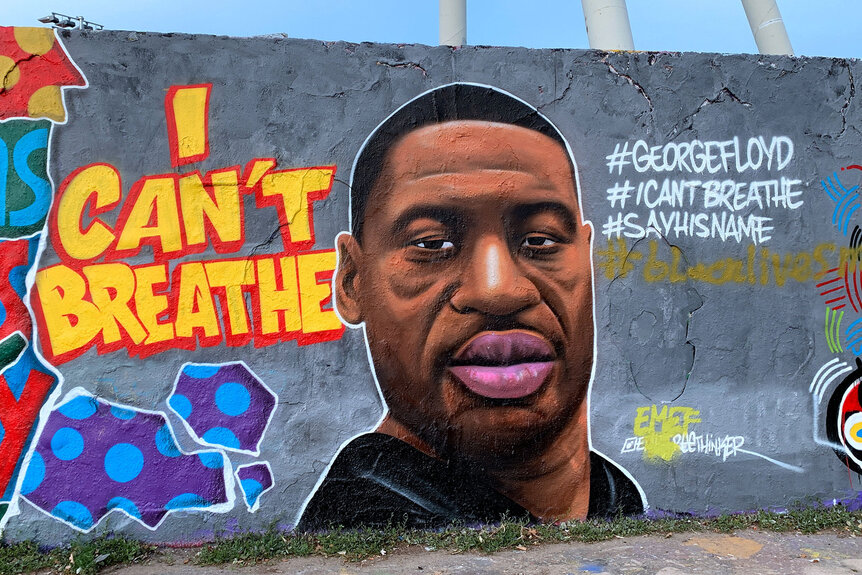Create a free profile to get unlimited access to exclusive videos, breaking news, sweepstakes, and more!
George Floyd Likely Couldn’t Breathe Even If He Was Talking, Medical Experts Say
“The ability to speak does not mean the patient is without danger,” an American Heart Association medical official told the AP.

As George Floyd repeatedly pleaded “I can’t breathe” to police officers holding him down on a Minneapolis street corner, some of the officers responded by pointing out he was able to speak. One told Floyd it takes “a lot of oxygen” to talk, while another told angry bystanders that Floyd was “talking, so he can breathe.”
That reaction — seen in police restraint deaths around the country — is dangerously wrong, medical experts say. While it would be right to believe a person who can’t talk also cannot breathe, the reverse is not true — speaking does not imply that someone is getting enough air to survive.
“The ability to speak does not mean the patient is without danger,” said Dr. Mariell Jessup, chief science and medical officer of the American Heart Association.
“To speak, you only have to move air through the upper airways and the vocal cords, a very small amount,” and that does not mean that enough air is getting down into the lungs where it can supply the rest of the body with oxygen, said Dr. Gary Weissman, a lung specialist at the University of Pennsylvania.
The false perception that someone who can speak can also take in enough air is not part of any known police training curriculum or practices, according to experts on police training and use of force.
“I’m not aware of any standard training of police officers that lets them know, ‘Hey, if someone is still able to talk they are not having difficulty breathing, so you can just keep doing what you are doing,’” said Craig Futterman, professor at University of Chicago Law School and an expert on use of force.
Floyd, a Black man who was handcuffed, died May 25 after Derek Chauvin, a white police officer, pressed his knee on Floyd’s neck for nearly 8 minutes, keeping Floyd pinned even after he stopped moving. In the moments before he died, Floyd told police he couldn’t breathe more than 20 times.
A transcript from one of two police body camera videos released Wednesday shows that at one point after Floyd said he couldn’t breathe and was being killed, Chauvin said: “Then stop talking, stop yelling. It takes a heck of a lot of oxygen to talk.”
Widely viewed bystander video shows Tou Thao, the officer who was managing people who had gathered, told the concerned crowd, “He’s talking, so he can breathe.”
The medical community disagrees.
In a recent article in the medical journal Annals of Internal Medicine, Weissman and others wrote that when air is inhaled, it first fills the upper airway, trachea and bronchi, where speech is generated. The article says this “anatomical dead space” accounts for about one third of the volume of an ordinary breath, and only air that gets beyond this space goes to air sacs in the lungs for gas exchange, which is when oxygen is sent to the bloodstream and carbon dioxide is removed as waste.
The volume of an ordinary breath is about 400 to 600 mL, but normal speech requires about 50 mL of gas per syllable, so saying the words “I can’t breathe” would require 150 mL of gas, the authors wrote.
A person can utter words by exhaling alone, using reserve left over after a normal breath is exhaled. But, the article says, “adequate gas exchange to support life requires inhalation. ... Waiting until a person loses the ability to speak may be too late to prevent catastrophic cardiopulmonary collapse.”
Minneapolis police spokesman John Elder said there is nothing in current training that instructs officers that a person who can talk while restrained is able to breathe. He said training surrounding the issue of talking and ability to breathe comes up only when discussing whether someone can speak or cough while choking on a foreign object — and even then, the person’s condition must be reassessed. Chief Medaria Arradondo has also said the restraint used by Chauvin was not taught by his department.
But the misperception that a talking person is able to breathe has also come up in other high-profile in-custody deaths.
Craig McKinnis died in May 2014 in Kansas City, Kansas, after he was restrained by police during a traffic stop. According to a federal lawsuit, McKinnis’ girlfriend said that after McKinnis cried, “I can’t breathe,” one of the officers said, “If you can talk, you can breathe.”
Eric Garner cried out “I can’t breathe” 11 times on a street in Staten Island, New York, in July 2014 after he was arrested for selling loose, untaxed cigarettes. Video shot by a bystander showed officers and paramedics milling around without any seeming urgency as Garner lay on the street, slowly going limp.
Officer Daniel Pantaleo, who performed the chokehold, was fired. Pantaleo’s defenders have included Rep. Peter King, a New York Republican, who said at the time that police were right to ignore Garner’s pleas that he couldn’t breathe.
“The fact that he was able to say it meant he could breathe,” said King, the son of a police officer.
“And if you’ve ever seen anyone locked up, anyone resisting arrest, they’re always saying, ‘You’re breaking my arm, you’re killing me, you’re breaking my neck.’ So if the cops had eased up or let him go at that stage, the whole struggle would have started in again.”
Futterman said best practices offer police training on positional asphyxiation and teach officers to roll a person onto his or her side for recovery, if necessary. And, he said, chokeholds or other restraints that restrict oxygen are considered deadly force, and can only be used as a last resort to prevent imminent threat of death or serious bodily harm.
He said just because a person is struggling does not give an officer the right to use deadly force.
According to a transcript of his interview with state investigators, Thomas Lane, the officer who was at Floyd’s legs, said that he’d had past experiences in which someone who was overdosing would pass out and then come to and be more aggressive. He told investigators that he asked if Floyd should be rolled onto his side, and after Chauvin said they would stay in position, he thought it made sense since an ambulance was on the way. Lane said he watched Floyd and believed he was still breathing.
Randy Shrewberry, executive director of the Institute for Criminal Justice Training Reform, said officers are supposed to ease up on any restraint once a person is under control.
“In the moment they are under control, or the moment you have someone restrained, is when everything stops,” Shrewberry said.























